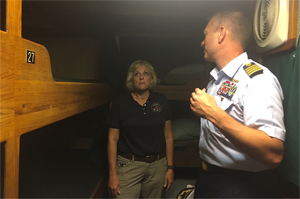Following the fatal fire on the dive boat Conception, the U.S. Coast Guard launched a nationwide inspection campaign last fall focused on safety and regulatory compliance aboard overnight passenger vessels.
The service also distributed a marine safety information bulletin (MSIB) highlighting key safety themes such as clear escape routes, crew readiness during emergencies, and hazards caused by too many personal electronic devices recharging at once.
Lt. Amy Midgett, a Coast Guard spokeswoman, said the “fleetwide safety campaign” occurred across all captain of the port zones. She acknowledged the effort was spurred by the Sept. 2 fire aboard Conception that claimed 34 lives.
“In the days immediately following the (fire), the Coast Guard launched a targeted inspection campaign on all small passenger vessels in the fleet to identify any immediate concerns and trends in the industry,” Midgett said in mid-November.
Although she described overall education as a primary objective, inspectors had the authority to identify deficiencies and take “other necessary enforcement action” based on issues they noticed while on board. Results from the nationwide inspection effort were still being tabulated, Midgett said.
Multiple federal agencies are investigating the Conception fire, which started at about 0300 while the vessel was anchored off California’s Santa Cruz Island. Crew told authorities they awoke to flames engulfing the ship’s galley on the main level. One deck below, 33 passengers and one crewmember slept. All 34 perished in the fire, while the five crew sleeping above the galley survived.
The National Transportation Safety Board (NTSB), Coast Guard and U.S. Justice Department are conducting separate investigations into the incident, Midgett said. The cause of the fire likely won’t be made public for a year or more, she said, adding that it was “too soon to speculate” whether any regulations might change as a result of the fire.
Kyle McAvoy, a former Coast Guard casualty investigator, predicted the service will recommend changes. McAvoy, who retired as captain and now works for Robson Forensic of Lancaster, Pa., expects the service will look at standards for safe passenger egress and hull materials that allowed the fire to spread quickly.
“One of the primary reasons to do an investigation is to figure out how to stop something from happening again,” said McAvoy, who is not connected to any of the Conception inquiries. “I foresee a critical look at all the regulations and policies in place, and a very high probability that some items will be proposed to change.”
Comments made by NTSB investigators shortly after the incident also offered clues of potential changes. The agency noted that Conception lacked a hard-wired fire alarm system and fixed fire-suppression system in the passenger spaces. Neither system was required.
Conception was built before regulatory changes in 1996 for small passenger vessels, and therefore it was not required to meet the more stringent Subchapter T standards.
“Conception was inspected and certificated by the Coast Guard as an existing small passenger vessel prior to the incident, and the process is informally referred to as ‘grandfathering’ in the maritime industry,” Midgett said.
During a tour of Conception’s sister vessel Vision after the fire, NTSB board member Jennifer Homendy expressed concern about the compartment where the victims slept in bunk beds stacked two and three high. The space had two exits, both of which led to the galley that was engulfed in flames. One of the exits required passengers to crawl over a bunk bed.
The Coast Guard has not specified any regulatory shortcomings aboard the 75-foot Conception. However, the inspection campaign that followed the tragedy re-emphasized its enforcement of existing regulations.
Inspectors came aboard the 39-passenger tall ship Harvey Gamage in Portland, Maine, in September as part of the nationwide compliance campaign. Capt. Richard Bailey, skipper of the ship certified under Subchapter T, said the inspectors called ahead of time to schedule the visit. He described the inspectors as “collaborative … and non-confrontational.”
“They looked at egresses from spaces, they looked at flammable possibilities — things like paint storage (and) phone charging,” he said.
Based on conversations with the inspectors, Bailey suggested the service “would like to reduce the number of overnight bunks aboard boats,” particularly double bunks catering to couples traveling together. Such accommodations, which Conception had, can trap one person between a sleeping partner and the bulkhead.
“On (Harvey Gamage), only the captain’s bunk is rated as a double,” Bailey said, “and there is nobody sleeping in there with me.”
Truth Aquatics of Santa Barbara, Calif., owned Conception, which was raised from the seafloor shortly after the fire. The company, now facing multiple lawsuits, has suspended operations “for a to-be-determined amount of time.”
“Right now we feel it’s important (to) dedicate our entire efforts to make our boats models of new regulations that we will continue to work on with the NTSB and Coast Guard,” the company wrote on its Facebook page.

